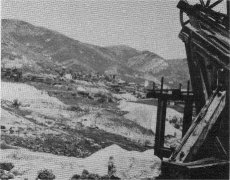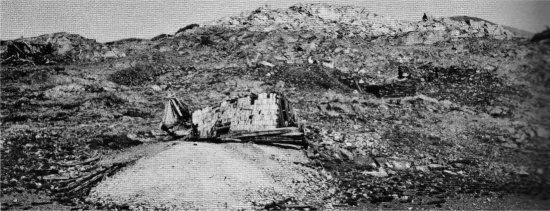
[click to enlarge]
TIOGA PASS ENTRANCE, YOSEMITE NATIONAL PARK
| Online Library: | Title | Author | California | Geology | History | Indians | Muir | Mountaineering | Nature | Management |
Yosemite > Library > Ghost Mines > 2. Discovery >
Next: 3. Speculation • Contents • Previous: 1. Fortune

[click to enlarge] TIOGA PASS ENTRANCE, YOSEMITE NATIONAL PARK |
TIOGA HILL lies in the Sierra Nevada about one mile northwest of Tioga Pass. Along its crest runs the eastern boundary of Yosemite National Park, and through its twisted and glacier-carved rocks runs a snow-white quartz—the mother lode of The Great Silver Belt.
There are several tales told about the discovery of The Sheepherder, most famous of these lodes. One goes like this: Early in 1860 Michael Magee, justice of the peace at Big Oak Flat during flush times in that camp, Captain A. S. Crocker, of Crocker’s Station, L. A. Brown, a surveyor, “Doc” George W. Chase, a dentist, and Professor Joshua E. Clayton of Mariposa were prospecting in the vicinity of Bloody Canyon. They camped near Tioga Pass to rest their animals and to look around. Clayton and Chase had been to the Mono Diggings the year before, and in returning home Chase crossed Tioga Hill and discovered the Sheepherder Lode. He may have been the first human to see its immense proportions. He kept mum about his discovery except perhaps to Clayton, who assayed his ore. While the 1860 party was camped at Lake Jessie (called Tioga Lake today) at the eastern base of Tioga Hill, Doc Chase remarked that if they could spend one day more there, he would locate and claim “the biggest silver ledge ever discovered”. Next day, while the others remained in camp, Chase, armed with a pick and shovel and a small tin can, struck out northward at daylight and ascended Tioga Hill by about the same course as the trail which now leads from the Great Sierra tunnel to the old works of the company on the hill. Reaching the Sheepherder Lode where it crosses a shallow ravine under a small lake, Chase unsoldered the can, straightened it out, and on the inner side scratched out his location notice with his knife. This he placed between two rocks on the massive croppings. Carrying as much ore as he could, he returned to camp. Next morning the party separated;
|
GLACIER POLISH, SIERRA NEVADA
[click to enlarge] 
|
CAPTAIN A. S. CROCKER
[click to enlarge] 
|
At Monoville they were to test the Tioga ore and Clayton was to devise a plan for a smelting furnace. But simultaneously with their arrival at Monoville there came in some men who had struck rich rock at what later became Aurora, Nevada. They had come over to get Clayton to make some assays. These ran so high that forgetting “the biggest silver ledge ever discovered” Clayton packed up his assaying outfit and the three started for Aurora. All made money as they followed new strikes. None returned, yet they never ceased telling their mining friends about the “thundering big silver ledge” on Tioga Hill.2
The news of a big silver ledge at the summit of the Sierra spread through Tuolumne and Mariposa counties in a short time, but soon passed into tradition amidst the excitement incident to the opening of the rich mines at Virginia City and Aurora. In 1874, as the story goes, 14 years after Chase’s discovery, the Sheepherder Lode was rediscovered by William Brusky, Jr., a boy from Sonora, Tuolumne County, who was tending a large band of sheep on Tioga Hill for his father. A rusty pick and broken shovel and the tin notice of location were found just as Dr. Chase had left them, except that the shovel had been almost destroyed by rust, and the location notice was illegible except the words, “Notice, we the undersigned” and the date 1860. Young Brusky had heard of the tradition and had been keeping on eye open for the ledge. Elated as he was when he made his discovery, he was disappointed when he returned home with samples of the ore. This his father pulverized in a mortar, panned, and pronounced worthless. The following summer, 1875, Brusky sank a small hole in the ledge and procured some better-looking ore. But still no one in Sonora would take any interest in it until the winter of 1877 when someone assayed the rock and found it to be rich in silver. Then everyone wanted to be in on the find.

[click to enlarge] MAY LUNDY MILL, SINCE DESTROYED BY FIRE |

[click to enlarge] VIRGINIA CITY, NEVADA, (1956) |

[click to enlarge] AURORA, MARK TWAIN’S OLD HOME, IS A GHOST TOWN TODAY |

[click to enlarge] DOOR, GREAT SIERRA CABIN |
Paralleling the Sheepherder Lode some 800 feet to the south is the ledge known as The Great Sierra. Among its mining claims are the Bevan, Ah Waga, Hancock, Atherton, and the High Rock. Perhaps the most important of these is the latter, site of the old village of Dana. Located originally by W. W. Rockfellow in October 1878 as the High Rock, it was later called the Mount Dana and finally the Great Sierra.3 Here, amidst unrivalled Sierran grandeur, stands a beautiful old stone cabin (see cover). Constructed of loose slate by an unknown craftsman, it is a masterpiece of dry-rock masonry. Its dirt-filled walls and heavy hand-made wooden door provided protection for many a miner when biting winds whistled across Tioga Hill.
A few yards to the north of the cabin are other buildings, now in ruins, nestled around two shafts—on inclined prospect shaft or the white mother lode, and a double compartment shaft which had been sunk 100 feet when summit work was abandoned.

[click to enlarge] DANA VILLAGE LIES IN RUINS |
Both shafts are water-filled now, and the horse-drawn lifting winch is rusting nearby. The Great Sierra hoisting works have succumbed to the elements such as the Homer Mining Index reported on November 12, 1881:
LUNDY, Nov. 12 — The wind was so terrific on Tioga Hill Wednesday night that it burst in the doors of buildings, and would have doubtless carried away the shaft house at the Great Sierra Mine but for the support given the buildings by the substantial gallows frame of the hoisting works.
Dana was going to be a real town. According to reports, “A postoffice has been created on Tioga Hill, to be known officially as Dana, and Frank W. Plains appointed postmaster; but Frank is down in Yosemite Valley for the winter and the emoluments of the office ($12.25 a year) don’t appear to be sufficiently attractive to induce him to climb 27 miles up the mountain on snowshoes to qualify.” 4
Next: 3. Speculation • Contents • Previous: 1. Fortune
| Online Library: | Title | Author | California | Geology | History | Indians | Muir | Mountaineering | Nature | Management |
http://www.yosemite.ca.us/library/ghost_mines/discovery.html